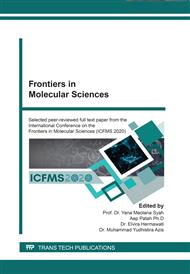p.3
p.13
p.20
p.28
p.35
p.45
p.50
p.58
p.69
Copper Amalgam Working Electrode for Voltammetric Determination of Selenite
Abstract:
Selenium is one of the heavy metal pollutants in the aquatic environment. Selenite is a form of inorganic selenium, which is very poisonous to living things. Therefore, we need a method that selectively identify selenite to determine its concentration in water. In this study, a square wave stripping voltammetry was used to measure selenite concentration using copper amalgam working electrode. The optimum measurement parameters were obtained at a deposition potential of –450 mV and a deposition time of 800 seconds. This analysis method had good precision with a relative standard deviation (% RSD) of 4.89%. Linear calibration curves are shown in the range 0.03 mM – 0.10 mM with R2 of 0.988 and in the range of 0.10 mM – 0.70 mM with R2 of 0.995 and a detection limit of 9.0 µM. The standard selenite solution was measured with a recovery percentage of 96.67%. The same solution was measured using the HG-AAS method and the recovery percentage was 96.35%. Statistical tests using the t-test showed that the two results did not have a significant difference with a 95% confidence limit. Thus, the voltammetry method using copper amalgam working electrode can be used as an alternative method for determining selenite, as it is cheaper and simpler than the HG-AAS method.
Info:
Periodical:
Pages:
35-44
Citation:
Online since:
January 2021
Keywords:
Price:
Сopyright:
© 2021 Trans Tech Publications Ltd. All Rights Reserved
Share:
Citation:


